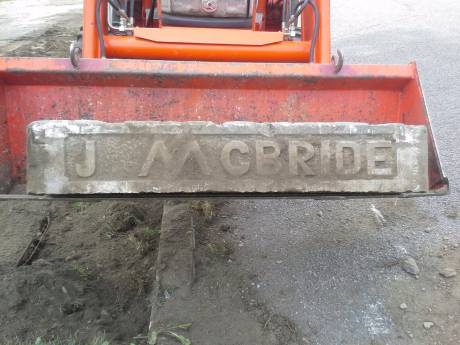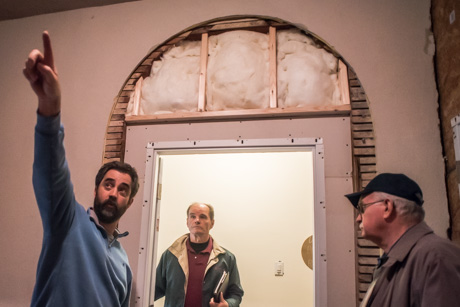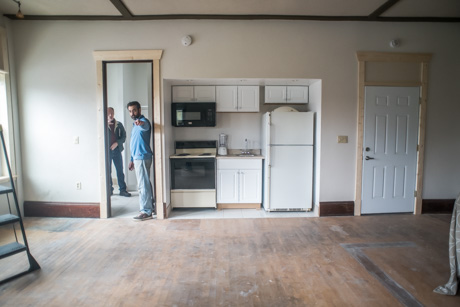Attorney for local landlord says criminal charges stem from dispute over sister's estate
A local landlord appeared in County Court today to enter a not guilty plea to a four-count indictment that accuses him of falsifying records and stealing Section 8 rent money from the state.
The charges stem from a dispute, said his attorney Fred Rarick outside of court, between James Pontillo and officials in Genesee County (see statement at bottom of the story for clarification) over the proceeds from the estate of Jeanne Veronica Pontillo, the 25-year-old sister of James Pontillo who died in 2012 from a rare form of cancer.
“There’s a lot more to this than him going out and saying 'I’m going to rip off my estate,' " Rarick said.
Jeanne Pontillo was not an official business partner with James Pontillo, but she helped him with his real estate investment business, Rarick said.
“If you just look at the history of James and his sister, they worked together very well for many, many years," Rarick said. "I’ve known Jeanne and James and I saw the way they worked together. She did the office and James bought the properties and refurbished them. They had an incredible relationship.”
James Pontillo is Jeanne's sole heir. Her estate included her personal residence.
After her death, James continued to manage that property, even renting it out with, according to Rarick, the blessings of the County Treasurer's Office (see statement at bottom of the story for clarification).
Everything was above board, Rarick said.
James Pontillo even paid all of the taxes on his sister's property. He also paid all of the funeral expenses instead of waiting for the estate to do it, Rarick said.
“Because," Rarick said, "ultimately he said, ‘it’s all coming to me anyway.’ ”
There are other allegations related to the handling of the estate by the County, but documentation was not immediately available.
Most arraignments are uneventful but two issues came up during Pontillo's arraignment today: A dispute over whether Pontillo had previously violated his release under supervision contract and a really unusual dispute over an order of protection.
There was a prior allegation that Pontillo left the county without properly notifying Genesee Justice. He apparently went to Monroe County to deal with property he owns there. According to Rarick, the issue was amicably resolved because there was some question as to whether the proper message got to the proper person at Genesee Justice, but Pontillo had called Genesee Justice about his plans.
As for the order of protection, typically, a temporary order of protection is issued to a defendant barring contact or harassment by the defendant of the crime victim, persons making an allegation or key witnesses.
District Attorney Lawrence Friedman tried to make just that point to Interim Judge Micheal Pietruszka today when a disagreement arose over an order barring Pontillo's contact with County Treasurer Scott German.
Pietruska asked Friedman if he anticipated any trouble and Friedman said he doesn't typically ask for orders of protection because he anticipates trouble, but because he wants to ensure there isn't a problem.
The request for an order left the territory of ordinary when Rarick noted that because of the ongoing estate case, Pontillo might have contact with German. Friedman said he wasn't aware of any example of anybody being arrested because they had contact with a person during normal court proceedings.
Pietruszka amended the order to ensure it didn't cover legal proceedings and Friedman expressed concern that the language was too vague.
At that point, Pietruszka plopped a big book of statutes on his desk and started thumbing through it and then read a passage covering the need to show cause for an order of protection. He then pressed Friedman to show cause.
Friedman said he didn't come prepared to argue that point because of the routine nature of an order of protection, so he didn't have the specifics in front of him, but there had been, he said, communication between Pontillo and German that would be of a concern.
Rarick then objected to the order, noting that the DA had failed to show cause. Pietruszka asked for the signed copy of the order back, said he was vacating it and ripped it up.
Pontillo was released under supervision of Genesee Justice.
Previously: Landlord accused of falsely claiming to own a dwelling in Batavia (we've covered James Pontillo extensively over the years and this story contains links to most of that prior coverage).
Photo: File photo of James Pontillo at his property in Stafford.
UPDATE: 4:50 p.m.: We emailed Scott German to give him a chance to respond. Here is his statement:
I will not comment on pending litigation. This litigation has nothing to do with the county, other county officials, or county attorney’s. The only reason I am involved is because I am the county treasurer and according to NYS law, when surrogates court determines there is no one qualified to serve as administrator of an estate, the surrogate names the county treasurer; I don’t get a choice. Apparently, at the time, the court determined no one was qualified to serve and I was appointed.












